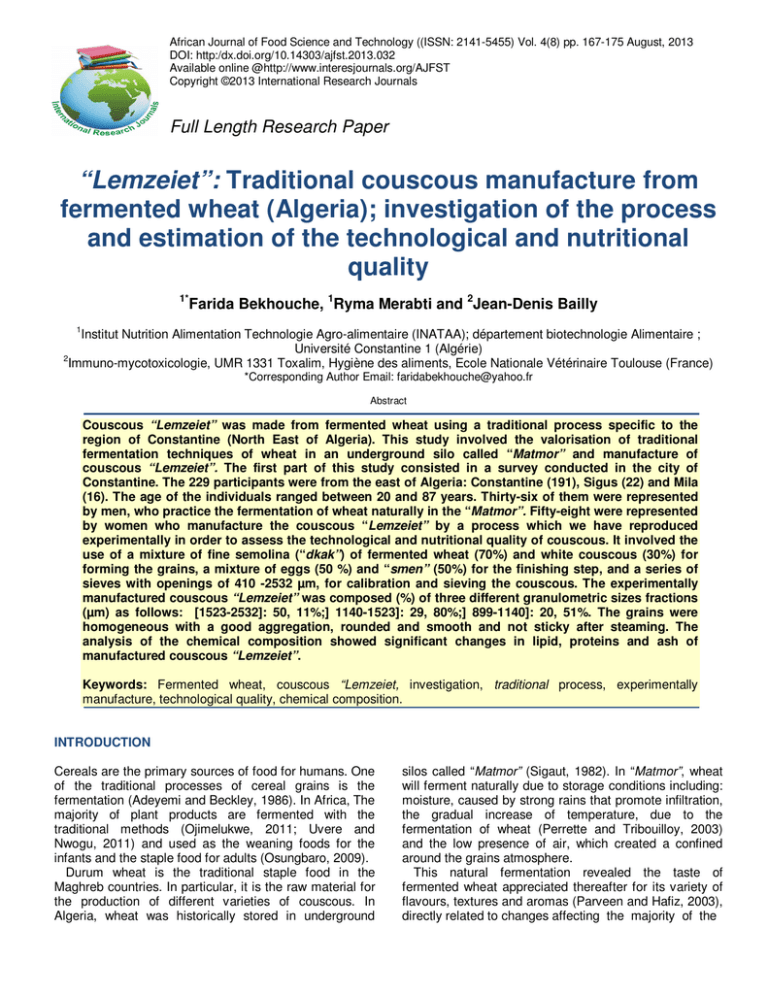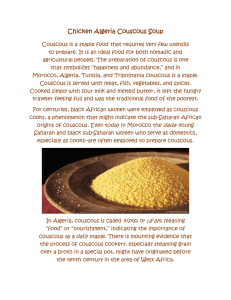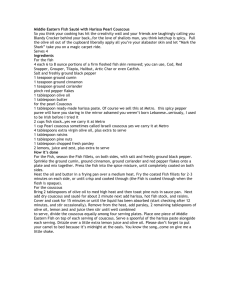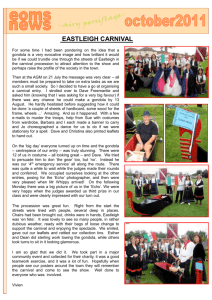Document 14105694
advertisement

African Journal of Food Science and Technology ((ISSN: 2141-5455) Vol. 4(8) pp. 167-175 August, 2013 DOI: http:/dx.doi.org/10.14303/ajfst.2013.032 Available online @http://www.interesjournals.org/AJFST Copyright ©2013 International Research Journals Full Length Research Paper “Lemzeiet”: Traditional couscous manufacture from fermented wheat (Algeria); investigation of the process and estimation of the technological and nutritional quality 1* Farida Bekhouche, 1Ryma Merabti and 2Jean-Denis Bailly 1 Institut Nutrition Alimentation Technologie Agro-alimentaire (INATAA); département biotechnologie Alimentaire ; Université Constantine 1 (Algérie) 2 Immuno-mycotoxicologie, UMR 1331 Toxalim, Hygiène des aliments, Ecole Nationale Vétérinaire Toulouse (France) *Corresponding Author Email: faridabekhouche@yahoo.fr Abstract Couscous “Lemzeiet” was made from fermented wheat using a traditional process specific to the region of Constantine (North East of Algeria). This study involved the valorisation of traditional fermentation techniques of wheat in an underground silo called “Matmor” and manufacture of couscous “Lemzeiet”. The first part of this study consisted in a survey conducted in the city of Constantine. The 229 participants were from the east of Algeria: Constantine (191), Sigus (22) and Mila (16). The age of the individuals ranged between 20 and 87 years. Thirty-six of them were represented by men, who practice the fermentation of wheat naturally in the “Matmor”. Fifty-eight were represented by women who manufacture the couscous “Lemzeiet” by a process which we have reproduced experimentally in order to assess the technological and nutritional quality of couscous. It involved the use of a mixture of fine semolina (“dkak”) of fermented wheat (70%) and white couscous (30%) for forming the grains, a mixture of eggs (50 %) and “smen” (50%) for the finishing step, and a series of sieves with openings of 410 -2532 µm, for calibration and sieving the couscous. The experimentally manufactured couscous “Lemzeiet” was composed (%) of three different granulometric sizes fractions (µm) as follows: [1523-2532]: 50, 11%;] 1140-1523]: 29, 80%;] 899-1140]: 20, 51%. The grains were homogeneous with a good aggregation, rounded and smooth and not sticky after steaming. The analysis of the chemical composition showed significant changes in lipid, proteins and ash of manufactured couscous “Lemzeiet”. Keywords: Fermented wheat, couscous “Lemzeiet, investigation, traditional process, experimentally manufacture, technological quality, chemical composition. INTRODUCTION Cereals are the primary sources of food for humans. One of the traditional processes of cereal grains is the fermentation (Adeyemi and Beckley, 1986). In Africa, The majority of plant products are fermented with the traditional methods (Ojimelukwe, 2011; Uvere and Nwogu, 2011) and used as the weaning foods for the infants and the staple food for adults (Osungbaro, 2009). Durum wheat is the traditional staple food in the Maghreb countries. In particular, it is the raw material for the production of different varieties of couscous. In Algeria, wheat was historically stored in underground silos called “Matmor” (Sigaut, 1982). In “Matmor”, wheat will ferment naturally due to storage conditions including: moisture, caused by strong rains that promote infiltration, the gradual increase of temperature, due to the fermentation of wheat (Perrette and Tribouilloy, 2003) and the low presence of air, which created a confined around the grains atmosphere. This natural fermentation revealed the taste of fermented wheat appreciated thereafter for its variety of flavours, textures and aromas (Parveen and Hafiz, 2003), directly related to changes affecting the majority of the 168 Afr. J. Food Sci. Technol. constituents of wheat (Jeantet et al., 2006a, b). The fermented wheat has then become part of the dietary habits and been used to make couscous “Lemzeiet” (name originated in Constantine), the knowledge being passed from one generation to another. Unlike other regional products of Algerian origin, couscous “Lemzeiet” remains little studied. This work has the following objectives: gather information about the fermented wheat and couscous “Lemzeiet” (under investigation); reproduce the traditional process of making couscous “Lemzeiet”; and perform a chemical analysis and technology assessment on the traditional finished product. MATERIALS AND METHODS Survey of fermented wheat and couscous “Lemzeiet” Conduct of the survey The survey was conducted in Constantine, with resident families in the old quarters of the city. The interview was conducted during the period of May-June-July (2011), with 229 adult individuals belonging to both sexes and selected on the basis of the results of a previous investigation (Bekhouche et al., 2007). To carry out the survey, a questionnaire was developed based on the following components: The first part involved the data relating to the identification and origin of the individuals involved; The second part concerned the description of the traditional practices of manufacturing couscous “Lemzeiet” and fermented wheat; The third part considered the different methods of preparation and consumption of traditional couscous “Lemzeiet”. Analysis of the results was performed using EPI-INFO software, version 6.04., and the results were expressed as % of response to each question in the survey. Experimental reproduction manufacture of “Lemzeiet” of the traditional The Reproduction of manufacturing steps (Figure 1) was carried out based on information collected during the investigation phase. We have used the same utensils (traditionally manufacture) and the same raw materials. The fermented wheat (Figure 2a) for the experimental production of couscous “Lemzeiet”, was origin of “Matmor” (Figure 2b) belonging to a farmer located in the region of Sigus (Oum-El Bouaghi, Algeria). After three years of fermentation, wheat grains were dried in the sun. They are black and brown colors, and with a special aroma. The wheat sample was stored in sealed jars. Traditional utensils The traditional utensils was used for manufacturing couscous are shown in Figure 2c. The guassaâ is a wooden container with the following dimensions: 58 cm (diameter of the upper part), 47 cm (diameter of the lower part) and 07 cm (height). The sieves used do not have the specific standards calibrations. They are made traditionally and consist of a metal fiber and a hoop supported by a wooden frame. To assess the openings of sieves, we selected randomly 10 rows of 10 squares, and we have calculated the average and standard deviation for values obtained for 100 openings dimensions. Five different sieves named “siyar ezzraâ”, “sekkat”, “meâaoudi”, “reffad” and “dakkak” are utilized in sieving or sizing operations and correspond respectively to 2532 ± 0.132 µm, 1523 ± 0.076 µm, 1140 ± 0.073 µm, 899 ± 0.071 µm and 410 ± 0.004 µm mesh opening. The steam-cooker is a kitchen utensil, composed of two parts. The lower part is used to boil water, the steam generated is used for cooking couscous, in the upper part called keskess. The latter is composed of small holes that allow the rising steam to cook the couscous. Materials used White couscous (Figure 2d) is used as the raw material for the manufacture of couscous “Lemzeiet”. It’s made according to the traditional process with the size particles superior to 500 µm. Semolina of dkak comes from the grinding of fermented wheat. To prepare the desired milling wheat, the grains were sorted manually to remove impurities. Washing was carried out by immersing the grains in cold water. The wheat was then removed from the water and then dried in the sun until it became dry. The milling of wheat was performed with an electric mill. Three fractions were obtained: bran, coarse semolina and fine semolina called “dkak” (Figure 2e). The first two fractions were recovered with the sieves siyar ezzraâ and mâaoudi, while semolina of “dkak” (< 410 µm) was permeated through the “dakkak”. It is the latter fraction which is traditionally used in the manufacture of couscous “Lemzeiet”. The mixture of eggs and “smen” was used in the final stage of the manufacture (Figure 2f). The “smen” is a salty butter which has undergone a refining during storage in order to acquire a special flavour appreciated by the local people of Constantine. Bekhouche et al. 169 Semolina of dkak n= 4+8 n= 1 n=4+8 Rolling a Sieving SM (1140 µm) Recycling step; n=8 Aggregating step Salted water (5 %) Hydrated white couscous Sizing SE (2532 µm) Sieving SM (1140 µm) n= 8 n= 8 Finishing step Rolling a Mixture Egg- smen Sieving SR (899 µm) Reject not used Steam cooking [98°C-100° C [ ; 10 min Rest period Ta: [20° C-25° C [; 12 hours a Emoting Sizing SE (2532 µm) Circular movement To and fro movement n: recycling steps SE: “Siyar ezzraâ” SM: “Mâaoudi” SR: “Reffad” SD: “Dakkak” a: “guessâa” Ta: temperature of laboratory Dry couscous Lemzeiet (Ø [500-1600[µm) Drying room Drying 24° C± 5° C; 24 hours Sizing SD (410 µm) Reject not used Figure1. Experimental process of couscous “Lemzeiet” manufacturing, according to the traditional procedure of Constantine region Steps of manufacturing Aggregating step In this first step, we used the proportions of the ingredients defined by the majority of the women interviewed: 980 g of “dkak” (70%), 420 g of white dry couscous (30%) and 650 g of salted water (5 g/ l).The white couscous was hydrated and prepared into the “guassaâ”, with progressive adjunction of amounts of salt water and of dkak. The mixture was rolled by circular movement with hands (Figure 3a), the operation was repeated four times alternately adding of salt water and of “dkak” until the grains were completely coated with “dkak” and acquired a brown colour. Sieving and sizing steps The sieve “siyar ezzraâ” was used to calibrate the 170 Afr. J. Food Sci. Technol. a c e b d f Figure 2. Utensils and Materials used: a: fermented wheat structure; b; entrance of “Matmor” silo c: Steam-cooker, Sieves and “guassaâ”; d: White couscous; e: semolina of “dkak”; d: eggs and “smen” couscous, in forcing the grains by hand pressure, in order to pass through the sieve (Figure 3b). The sieving was performed with the sieve “Mâaoudi” (Figure 3c), for separate the couscous and non-aggregated particles. These have been put in the “guassaâ” to undergo a new cycle. obtained were firm and not sticky. To speed up the drying, the couscous was dried a drying-room (Memmert model 700) at 24 ° C ± 5 ° C for 24 hours. These conditions allowed us to obtain dry grains (Figure 3f). After drying, the couscous “Lemzeiet” was kept in a jar for analysis. Finishing step Couscous productivity This step was carried out on grains preformed. A small amount of the mixture of two ingredients (eggs: 25 g; smen: 25 g) was distributed on the palms of hands to roll couscous in to and fro movement (Figure 3d). The procedure was repeated eight times to obtain smooth and shiny grains. The couscous was recovered by the sieve “reffad” and was spread thinly on a white cloth, at room temperature (20 °C-25 °C; 12 h) to favour a good adhesion of the mixture (eggs and “smen”) on the surface of grains and prepare them for the cooking step (Figure 3e). The yield (R %) of couscous “Lemzeiet” manufactured, was evaluated in relation to matter that was used for its manufacture (g), as follows: R% = dry couscous X100/ dry white couscous + dry semolina dkak + egg -“smen”. Couscous granulometry The granulometry of the dry couscous Lemzeiet” was obtained by passing the total mass of couscous manufactured through sieves following: “siyar ezzraâ”, “sekkat” “mâaoudi”, “Reffad” and “dakkak”. Cooking and drying The cooking of couscous was performed in the steamcooker. The cooking time was evaluated by observing the appearance of vapour on the surface of couscous (10 min, 98 ° C). Sizing with “sekkat” sieve and emoting operations were practised and the couscous grains Chemical analysis of fermented wheat and couscous “Lemzeiet” The analysis was carried out after the drying step. The moisture content, total protein, fat and minerals, were Bekhouche et al. 171 a b c d e f Figure 3. Steps principals used for manufacturing process of couscous “Lemzeiet” according to the traditional procedure of Constantine region. a: aggregating step (circular movement); b: sizing process; c: sieving process; d: finishing step (to and fro movement); e: Rest period; f: couscous “Lemzeiet” after cooking and drying evaluated using standard techniques of the French Association for Standardization (AFNOR, 1991). The results are expressed in g per 100 g of product after the drying step, on mean of six trials. Humidity was carried out in a drying-room (Memmert model 700) at a temperature between 130 and 133 °C until a constant mass was obtained (NF V 03-707). Ashes were mineralized (HERAUS M110) at 900 °C ± 25 °C until complete combustion of organic matter (NF V03-720). Total Proteins were evaluated by the Kjeldahl method (NF V 03-050), from the total nitrogen content multiplied by the conversion factor of 5.7 (Godon and Loisel, 1991). Total lipids were obtained by extraction with hexane at 140 °C (NF 03-713), using an extractor (SOXLHET; system HT1043). The micelle phase (solvent and lipid) was isolated, the solvent was evaporated and the lipid fraction was recovered to be weighed. starch are sedimented. Starch is well dissolved in the HCL solution and then precipitated with ethanol and determined gravimetrically (FAO, 1986a). RESULTS AND DISCUSSION Survey Identification and origin of the individuals involved The age of the individuals ranged between 20 and 87 years. They were classified by age bracket of 20 years (20-80 years) and 10 years (80-90 years). The geographical origin of individuals mainly corresponds to regions in eastern Algeria: Constantine (191), Sigus (22) and Mila (16). This confirms that couscous “Lemzeiet” is a product of the local area (Table 1). Starch Description of traditional practices The method is based on the dissolving of proteins and other nitrogen compounds, lipids and salts in an alcoholic solution of potassium hydroxide. Lipids are saponified and proteins are hydrolysed. The pigments, cellulose and Fermentation of durum wheat in the “Matmor” The survey identified 36 people, male, who still practice the traditional fermentation of durum wheat, in their 172 Afr. J. Food Sci. Technol. Table1. Distribution of individuals according to age groups, the origins and the practice of the wheat fermentation and couscous “Lemzeiet” manufacturing Constantine women men 1 2 3 44 16 26 47 30 31 10 8 21 2 6 6 107 56 84 Ages groups [20-40] [40-60] [60-80] [80-90] Totals Sigus women men 4 5 6 0 0 0 0 22 22 0 0 0 0 0 0 0 22 22 Mila women 7 8 0 0 0 0 2 2 0 0 2 2 men 9 10 0 0 0 0 14 14 0 0 14 14 [1, 3, 4, 5, 7, 9]: Number of individuals interviewed, [2, 8]: number of women manufacturers couscous “Lemzeiet”, [6, 10]: number of individual practitioners fermentation of wheat in “Matmor”. Table 2. Proportions (g / 100) of materials used for production of couscous “Lemzeiet” Answers (%) 0 ,00 53,60 12,70 34,70 Proportions “dkak” White Couscous 100 0,00 70,00 30,00 50,00 50,00 100% fermented wheat dkak Semolina 66,66 33,33 regions of origin (Table 1). The fermentation time in “Matmor” is from a few months to 9 years. The colour of wheat after fermentation differs depending on its position in the “Matmor”: The wheat is red in bottom; it is brown or yellow in the periphery. In all cases, in the output of “Matmor”, the wheat is very humid. Manufacture of couscous “Lemzeiet” The results of the survey show that only women manufactured the couscous. Most of them are from Constantine and aged 40 to 60 years. The knowledge is transmitted from one generation to another. The couscous manufacturing requires the use of fermented durum. For this, women buy the fermented wheat in the dry state, from artisan merchants of cereals. The degree of drying grain is evaluated by crushing a few grains in the mouth. This step appears to be very important and necessary to obtain a satisfactory grinding. The traditional wheel formerly used is now replaced by the electric mill. The grinding is performed among the traders who sell the fermented wheat. All the women interviewed adopted the same technique for manufacturing couscous and a few variations in the proportions of matter were noted. For example, we noticed that 53.60% of women manufactured the 80,00 Proportions eggs “smen” 50,00 50,00 10,00 20,00 80,00 07,00 0,00 100 03,00 0,00 0,00 Answers (%) couscous using the following proportions: 70% of white couscous and 30% of “dkak”. Just over 34% of women preferred to use 100 % fermented wheat, with the proportion of 66.66% of “dkak” and 33.33% of coarse semolina. 80% of women also confirmed that the mixture of 50% of eggs and 50% smen is most often used during the finishing rolling step (Table 2). The drying of couscous “Lemzeiet” is practiced under shade and natural air in order to better develop the smell and it is returned regularly. Drying is evaluated by touching and the cracking of grains between the teeth. The sieving of the couscous is necessary at the end of drying. After, the couscous “Lemzeiet” is stored in cloth bags, for periods up to a year or more, in a cool place. Traditional of preparation couscous “Lemzeiet” and consumption of Technically preparation Couscous “Lemzeiet” is consumed in sauce with different types of food. The responses indicate that the couscous can have several flavours depending on the method of preparation. The investigation revealed that the sauce for couscous could be associated with different types of vegetables, according to the seasons and food Bekhouche et al. 173 Table 3.Numbers of individuals consuming the couscous “Lemzeiet” (1) and those who do not consume (2) Ages groups [20-40] [40-60] [60-80] [80-90] Totals 1 women men Totals 40 9 49 41 42 83 12 35 47 6 6 12 99 92 191 2 women men Totals 4 17 21 6 11 17 0 0 0 0 0 0 10 28 38 Table 4.Mass balance of couscous “Lemzeiet” manufacturing according to the traditional process Materials used (g) White couscous Semolina of dkak 420 980 Mixture eggs- smen 50 preferences. Although mutton is preferred, other meats are also used. Different sources of fat (rapeseed, sunflower, olive, margarine, butter, or “smen”) are integrated into the couscous and the sauce that accompanies it. The salt and a variety of spices (black pepper) are also included. Consumption The 191 individuals (women and men) said that their reasons for eating this dish (Table 3) are its nice taste (80%), its ease of preparation, its low cost (14%) and it is perceived to be good for health (6%). The most important argument presented by the women interviewed, is the traditional character of the consumption of couscous “Lemzeiet” as it is used since generations on the fortieth day of funerals where families are cordially invited. Experimental manufacture of couscous “Lemzeiet” The manufacture of couscous “Lemzeiet” is accompanied by the appearance of three granulometry fractions of different sizes and proportional to the amount of couscous grains. Thus, for of production of 1307 g, the fraction lost during manufacturing was estimated at 360 g. We have concluded that there was no potential loss of matter used during the process, because the yield of the total production (93.13%) obtained was high (Table 4 and Figure 4). The process of manufacturing traditional couscous “Lemzeiet” has a number of differences, with the traditional manufacturing of non-fermented wheat couscous. Indeed, some steps do not appear in the manufacture of couscous “Lemzeiet”. The forming of grains is the first step in the manufacture of non- Salted water 650 Total Dried mass (g) Productivity (%) 1450 1307 93,13 fermented wheat couscous. It involves shaping the core of couscous (Benatallah et al., 2008). In the manufacture of couscous “Lemzeiet”, this step was replaced by the direct use of white couscous previously manufactured. And during the finishing step, the mixture of eggs and “smen” was used specifically for the manufacture of couscous “Lemzeiet”. It had the same criteria defined by different authors for the technological qualities of couscous made from unfermented wheat: the grains are homogeneous, rounded, oval and smooth. After steaming, the grains were firm and not sticky (Kaup and Walker, 1986; Guezlane and Abecassis, 1991; Aboubakar and Hamaker, 1999, 2000). Chemical composition Due to the lack of data on the fermented wheat and the couscous “Lemzeiet”, the results (Table 5) were compared to results quoted by different authors for the unfermented products (durum wheat and couscous). The fermented wheat taken directly from the “Matmor” had a moisture content of 40%. For our sample, the fermented wheat was dried and its moisture was 12.999 ± 0.055%. It is within the standards for optimal use (FAO, 1996; Fredot, 2006). The moisture content obtained in the couscous “Lemzeiet” (12.186 ± 0.003) did not exceed the value (12 to 13%) observed for the non-fermented wheat couscous (FAO, 1996; Derouiche, 2003). This moisture provides product conservation for a long time. Total proteins are often hydrolyzed in polypeptides and in amino acids. They are used in microbial metabolism. This explains the low value obtained in our sample of fermented wheat (10.099 ± 0.011), compared with nonfermented wheat (≤ 11.5%: Codex Alimentarius FAO, 1994). The protein content of couscous “Lemzeiet” was 174 Afr. J. Food Sci. Technol. 655, 01 600 500 400 383,995 ) Mass (g ) 700 268,045 300 200 100 0 ] 1523-2532] ] 1140 -1523] ] 899 - 1140] Granulometric sizes (µm) RFC 50,110 % 29,380 % 20,510 % RT : 93, 13 % Figure 4.Granulometry distribution of the manufactured couscous “Lemzeiet”; R: Total productivity of Dry Couscous, RFC = productivity of three fractions Table 5.Major components of products (g /100 g) n=6 fermented wheat Couscous“Lemzeiet” Humidity 12,999 ± 0,055 12,186 ± 0,003 Total Proteins 10,099 ± 0,011 09,610 ± 0,021 Ashes 01,986 ± 0,039 02,223 ± 0,022 Total Lipids 06,672 ± 0,049 02,870 ± 0,019 Starch 54,392 ± 0,022 67,429 ± 0,091 Total carbohydrates* 68,244 73,111 *: Total Carbohydrates values obtained by difference (FAO, 1980). even lower (9.610 ± 0.021) in spite of the fact that we added the eggs during its preparation. Furthermore, it was less than that in non-fermented wheat couscous (12.60%: Dagher, 1991). The part of wheat aleuronic (rich in proteins) of grains used for the preparation of couscous, are eliminated in part by grinding and sifting. The value of total lipids in the fermented wheat is 2.870 ± 0.019. It lies within the range of values (2-3%) obtained by Godon (1991b). The lipid content in our couscous samples was (6.672 ± 0.049) and higher than that observed (1.1-1.4%) in the non-fermented wheat couscous (Dagher, 1991; Derouiche, 2003). The systematic incorporation of the “smen” during manufacture may explain this result. The presence of this fat in the couscous improves is quality after cooking: increased swelling and decreased caking couscous (Khendek and Guezlane, 1994; Ounane et al., 2006). According to Feillet (2000), the percentage of starch is between 67 and 68% in the non-fermented wheat grain. The low proportions obtained in the fermented wheat (54.392 ± 0.022), could be explained by the partial hydrolysis of starch by microbial enzymes or amylases present in grain during fermentation (Bauer et al., 2010). Contrary to the amount of starch in the couscous (56.980 ± 0.057), which was higher than that of wheat used for his process. This result is explained by the addition of a substantial proportion, rich in starch, of “dkak” semolina (70%) and white couscous, during manufacture (Dunford, 2012). The ash value obtained in the fermented wheat (1.986 ± 0.039) is comparable to the value (≤ 2.1%) of Codex Alimentarius (FAO, 1996). The ash content (2.223 ± 0.022) recorded in the couscous “Lemzeiet” is significantly higher than that of non-fermented wheat couscous (1.26 ± 0.04%) obtained by Guezlane et al., (1986). This result can be explained by the ingredients (salt, eggs and fat) that provide additional quantities of minerals. CONCLUSION The survey conducted in this study shows that the Bekhouche et al. 175 manufacture of couscous “Lemzeiet” is a tradition that still exists in Constantine. However, the fermentation of wheat in the “Matmor” tends to disappear due to the settlement of rural populations in urban areas. However, an alternative begins to develop in the city of Constantine due to the supply difficulties of fermented wheat: wheat fermentation in the barrels. Fermented wheat in “Matmor” undergoes changes affecting the major components (proteins and starches) and the organoleptic characteristics are developed. The manufacture process of couscous “Lemzeiet” compensates the decrease of certain components during the fermentation of wheat grains. The different ingredients used in the manufacture are an asset to offset the deficit in nutrients. The experimental reproduction of couscous “Lemzeiet” manufacture helped to highlight the feasibility of the traditional technique of manufacturing and evaluating of technological and nutritional quality of couscous. REFERENCES Aboubacar A, Hamaker BR (1999). Physicochemical Properties of Flours that Relate to Sorghum Couscous Quality, Cereal Chem. 76:308 - 313 Aboubacar A, Hamaker BR (2000). Low molecular weight soluble starch and its relationship with sorghum couscous stickiness. J. Cereal Sci. 31:119-126. Adeyemi IA, Beckley O (1986). Effect of period of maize fermentation and souring on chemical properties and amylograph pasting viscosities of ogi. J. Cereal Sci. 4: 353-360 AFNOR (1991). Normes : NF V 03-707 (juin 1989), NF V 03-720 (décembre 1981), NF V 03-713 (février 1984); NF V 03-050 (septembre 1970), In recueil des normes françaises, contrôle de la qualité des produits alimentaires, Céréales et produits céréaliers, ème AFNOR/DGCCRF, 3 édition, Paris 360 pages. Bauer WJ, Badoud R, Löliger J, Etournaud A (2010). Sciences et technologies des aliments, principe de chimies des constituants et de technologie des procédés. Presses Polytechniques. 720 pages. Bekhouche F, Nessah K, Mekhancha De (2007). Nutritional information on “Lemzeiet”: couscous manufactured traditionally with fermented nd durum wheat. 2 International Euro FIR Congress: Role of food composition data in improving quality, healthiness and safety of European diets, 26-27th September 2007, Granada, Spain. Benatallah L, Agli A, Zidoune MN (2008). Gluten-free couscous preparation: Traditional procedure description and technological feasibility for three rice-leguminous supplemented formulae, J. Food Agric. and Environ. 6 (2):105-112. Dagher SM (1991). Traditional food in the Near East, FAO, food and nutrition paper 50, Rome. 161 pages Derouiche M (2003). Couscous : Enquête de consommation a Constantine, fabrication artisanale et qualité, mémoire de Magister, option Nutrition Humaine, I.N.A.T.A.A., Université Constantine 1 (Algérie). 125 pages. Dunford NT (2012). Food and industrial bioproducts and bioprocessing. Wiley-Blackwell, 392 pages. FAO (1986a). Manuel of Food Quality Control, 7-Food Analysis: General Techniques, Additives, Contaminants and Composition, FAO Food and Nutrition paper (7)14: 238 pages. FAO (1994). Céréales, légumineuses, produits dérivés et protéines végétales, In Codex Alimentarius, FAO/OMS, 2ème édition, Rome. 7 :101 pages. FAO (1996). Codex Alimentarius : 7-Céréales, légumes secs, légumineuses, produits dérivés et protéines végétales, FAO, 2ème édition, Rome.164 pages. Feillet P (2000). Le grain de blé : composition et utilisation, I.N.R.A., Paris 308 pages. Fredot E (2006). Connaissance des aliments. Bases alimentaires et nutritionnelles de la diététique, Tec. Doc. Lavoisier, Paris. 397 pages. Godon B (1991b). Les constituants des céréales : nature, propriétés et teneurs, Biotransformation des produits céréaliers, I.N.R.A./A.P.R.I.A, Tec. Doc. Lavoisier, Paris. 679 pages. Godon B, Loisel W (1991). Dosage des protéines, Techniques d’analyse et de contrôle dans les industries Agro-alimentaires, MULTON JL, Analyse des constituants alimentaires. 2èmeédition, Tec. Doc. Lavoisier, Paris, Tome 4 : 450 pages. Guezlane L, Abecassis J (1991). Méthodes d’appréciation de la qualité culinaire du couscous de blé dur. I. A. A.11: 966-971. Guezlane L, Selselet-Attou G, Senator A (1986). Etude comparée de couscous de fabrication industrielle et artisanale, Industries des céréales. 43: 25-29. Jeantet R, Croguennec T, Schuck P, Brule G (2006a). Stabilisation biologique et physicochimique, Science des aliments, Biochimie Microbiologie Procédé–produits, Tec. Doc. Lavoisier, Paris. 1: 383 pages. Jeantet R, Croguennec T, Schuck P, Brule G (2006b). Technologie des produits alimentaires, In Science des aliments, BiochimieMicrobiologie-Procédés–produits, Lavoisier, Tec. et Doc., Paris, 2: 456 pages. Kaup SM, Walker CE (1986). Couscous in North Africa. Cereal Food World. 31:179-182. Khendek D, Guezlane L (1994). Rôle des monoglycérides dans l’expression de la qualité technologique du couscous industriel de blé dur. Céréaliculture, 32:10-14. Ojimelukwe PC, Okechi A, Ojinnaka MC (2011). Physicochemical characteristics of fermenting castor seeds containing lime and NaCl as additives. Afri. J. Food Sci. 5(14): 754-760. Osungbaro TO (2009). Physical and nutritive properties of fermented cereal foods. Afr. J. Food Sci. 3(2): 023-027. Ounane G, Cuq B, Abecassis J, Yesli A, Ounane SM (2006). Effect of physicochemical characteristics and lipid distribution in Algerian durum wheat semolina on the technological quality of couscous. Cereal Chem. 83 (4):377-384. Parveen S, Hafiz F (2003). Fermented cereal from indigenous raw materials Pakistan. Pakistan J. Nutrition. 2(5): 289-291. Perrette L, Tribouilloy B (2003). Essais de fermentation de grains de blé et de tournesol bruts. Evaluation pour chacun de ces produits du risque de transition entre le phénomène de fermentation et celui d’auto-échauffement, INERIS DRA. LPe.2001.P26260.doc. 30 pages Sigaut F (1982). Evolution historique des techniques et des politiques de stockage, Conservation et stockage des grains et graines et Produits dérivés. Céréales, oléagineux, protéagineux, aliment pour animaux, MULTON JL, Tec. Doc. Lavoisier APRIA, Paris. 1 : 61-81. Uvere PO, Nwogu NA (2011). Effect of rehydration and fermentation methods on the quality of garri produced from stored cassava chips. Afr. J. Food Sci. 5 (13) : 728-732. How to cite this article: Bekhouche F, Merabti R and Bailly JD (2013). Lemzeiet: Traditional couscous manufacture from fermented wheat (Algeria); investigation of the process and estimation of the technological and nutritional quality. Afr. J. Food Sci. Technol. 3(8):167175




